Analyzing Clinical Reasoning in Nursing: Mrs. Kennedy's Case Study
VerifiedAdded on 2022/10/06
|7
|1867
|17
Report
AI Summary
This report presents a comprehensive analysis of Mrs. Carole Kennedy's case, focusing on the application of the clinical reasoning cycle in nursing practice. Mrs. Kennedy, a 56-year-old female admitted for pneumonia with a history of ischemic heart disease, hypertension, and peripheral vascular disease, experiences sudden changes in her condition, including chest pain, shortness of breath, and abnormal vital signs. The report analyzes the pathophysiological changes, prioritizing nursing care to ensure normal breathing, maintain blood flow, and address psychological issues like loneliness and depression. It explores the importance of assessing clinical manifestations, understanding the underlying pathophysiology of conditions like heart failure, and implementing appropriate nursing interventions. The report emphasizes the need for nurses to consider both the physical and psychological needs of the patient, highlighting the benefits of clinical reasoning for both the patient and the healthcare team. The conclusion underscores the value of clinical reasoning in framing medical interventions, evaluating patient outcomes, and facilitating continuous learning in nursing practice, supported by relevant references.
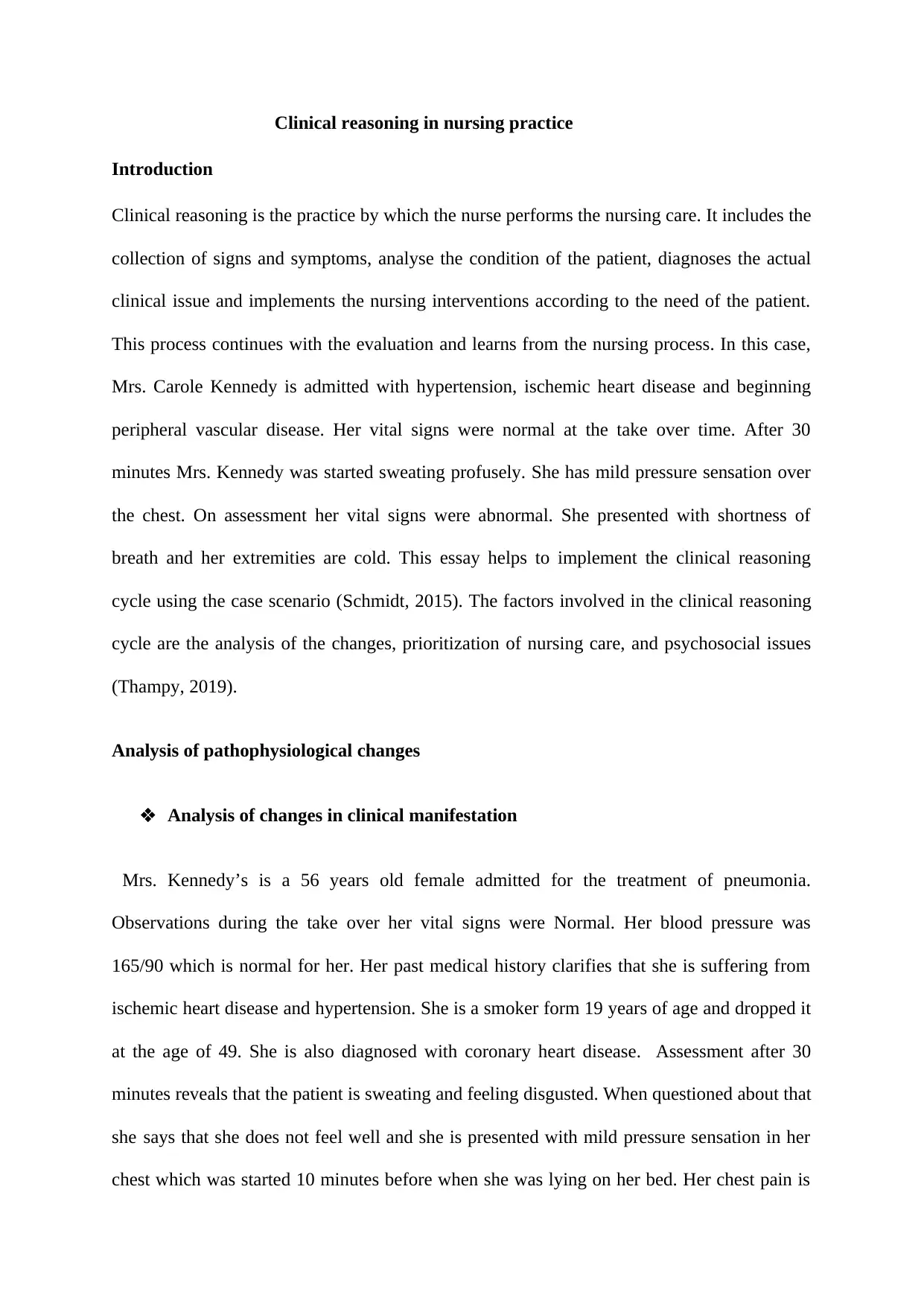
Clinical reasoning in nursing practice
Introduction
Clinical reasoning is the practice by which the nurse performs the nursing care. It includes the
collection of signs and symptoms, analyse the condition of the patient, diagnoses the actual
clinical issue and implements the nursing interventions according to the need of the patient.
This process continues with the evaluation and learns from the nursing process. In this case,
Mrs. Carole Kennedy is admitted with hypertension, ischemic heart disease and beginning
peripheral vascular disease. Her vital signs were normal at the take over time. After 30
minutes Mrs. Kennedy was started sweating profusely. She has mild pressure sensation over
the chest. On assessment her vital signs were abnormal. She presented with shortness of
breath and her extremities are cold. This essay helps to implement the clinical reasoning
cycle using the case scenario (Schmidt, 2015). The factors involved in the clinical reasoning
cycle are the analysis of the changes, prioritization of nursing care, and psychosocial issues
(Thampy, 2019).
Analysis of pathophysiological changes
Analysis of changes in clinical manifestation
Mrs. Kennedy’s is a 56 years old female admitted for the treatment of pneumonia.
Observations during the take over her vital signs were Normal. Her blood pressure was
165/90 which is normal for her. Her past medical history clarifies that she is suffering from
ischemic heart disease and hypertension. She is a smoker form 19 years of age and dropped it
at the age of 49. She is also diagnosed with coronary heart disease. Assessment after 30
minutes reveals that the patient is sweating and feeling disgusted. When questioned about that
she says that she does not feel well and she is presented with mild pressure sensation in her
chest which was started 10 minutes before when she was lying on her bed. Her chest pain is
Introduction
Clinical reasoning is the practice by which the nurse performs the nursing care. It includes the
collection of signs and symptoms, analyse the condition of the patient, diagnoses the actual
clinical issue and implements the nursing interventions according to the need of the patient.
This process continues with the evaluation and learns from the nursing process. In this case,
Mrs. Carole Kennedy is admitted with hypertension, ischemic heart disease and beginning
peripheral vascular disease. Her vital signs were normal at the take over time. After 30
minutes Mrs. Kennedy was started sweating profusely. She has mild pressure sensation over
the chest. On assessment her vital signs were abnormal. She presented with shortness of
breath and her extremities are cold. This essay helps to implement the clinical reasoning
cycle using the case scenario (Schmidt, 2015). The factors involved in the clinical reasoning
cycle are the analysis of the changes, prioritization of nursing care, and psychosocial issues
(Thampy, 2019).
Analysis of pathophysiological changes
Analysis of changes in clinical manifestation
Mrs. Kennedy’s is a 56 years old female admitted for the treatment of pneumonia.
Observations during the take over her vital signs were Normal. Her blood pressure was
165/90 which is normal for her. Her past medical history clarifies that she is suffering from
ischemic heart disease and hypertension. She is a smoker form 19 years of age and dropped it
at the age of 49. She is also diagnosed with coronary heart disease. Assessment after 30
minutes reveals that the patient is sweating and feeling disgusted. When questioned about that
she says that she does not feel well and she is presented with mild pressure sensation in her
chest which was started 10 minutes before when she was lying on her bed. Her chest pain is
Paraphrase This Document
Need a fresh take? Get an instant paraphrase of this document with our AI Paraphraser
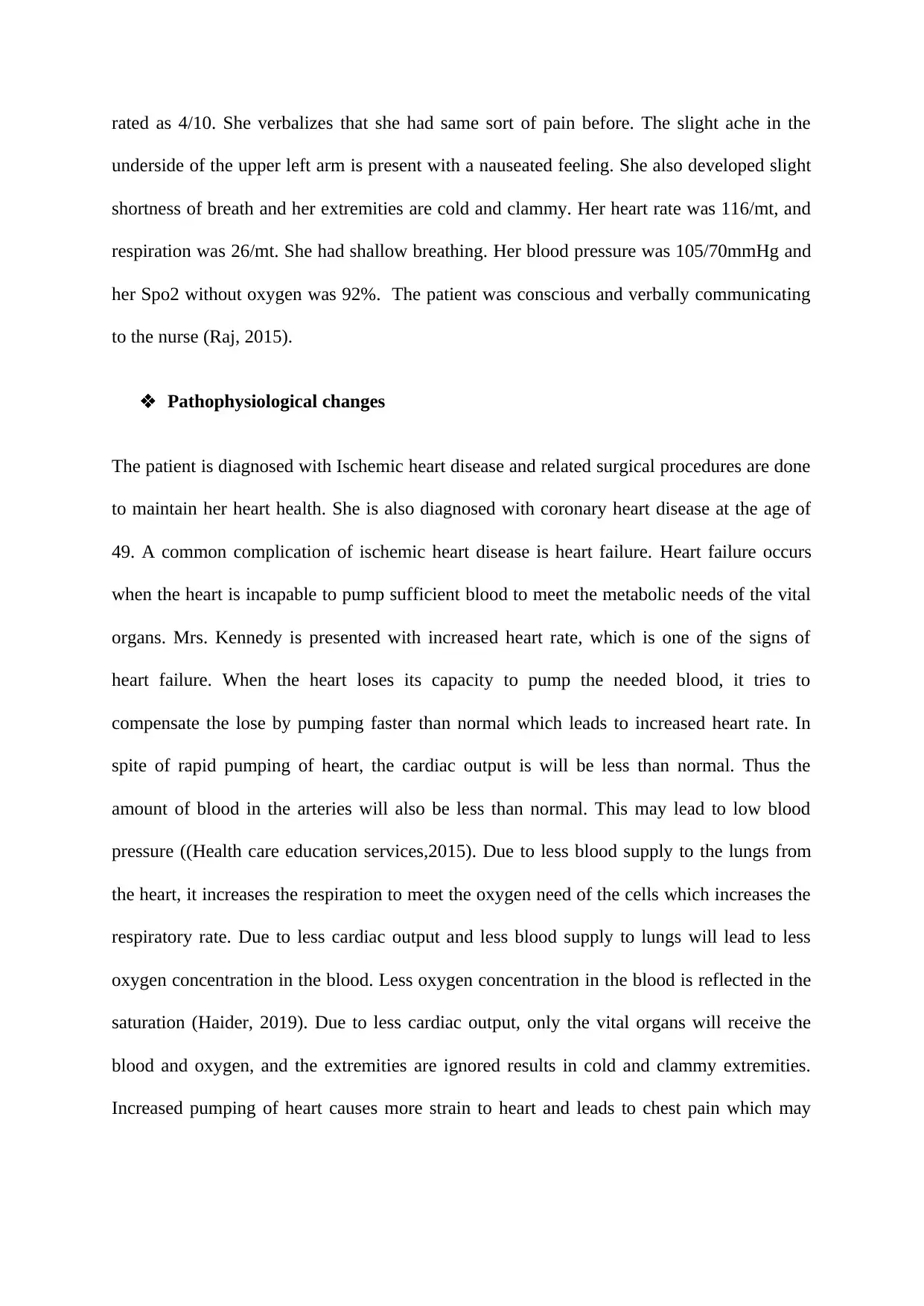
rated as 4/10. She verbalizes that she had same sort of pain before. The slight ache in the
underside of the upper left arm is present with a nauseated feeling. She also developed slight
shortness of breath and her extremities are cold and clammy. Her heart rate was 116/mt, and
respiration was 26/mt. She had shallow breathing. Her blood pressure was 105/70mmHg and
her Spo2 without oxygen was 92%. The patient was conscious and verbally communicating
to the nurse (Raj, 2015).
Pathophysiological changes
The patient is diagnosed with Ischemic heart disease and related surgical procedures are done
to maintain her heart health. She is also diagnosed with coronary heart disease at the age of
49. A common complication of ischemic heart disease is heart failure. Heart failure occurs
when the heart is incapable to pump sufficient blood to meet the metabolic needs of the vital
organs. Mrs. Kennedy is presented with increased heart rate, which is one of the signs of
heart failure. When the heart loses its capacity to pump the needed blood, it tries to
compensate the lose by pumping faster than normal which leads to increased heart rate. In
spite of rapid pumping of heart, the cardiac output is will be less than normal. Thus the
amount of blood in the arteries will also be less than normal. This may lead to low blood
pressure ((Health care education services,2015). Due to less blood supply to the lungs from
the heart, it increases the respiration to meet the oxygen need of the cells which increases the
respiratory rate. Due to less cardiac output and less blood supply to lungs will lead to less
oxygen concentration in the blood. Less oxygen concentration in the blood is reflected in the
saturation (Haider, 2019). Due to less cardiac output, only the vital organs will receive the
blood and oxygen, and the extremities are ignored results in cold and clammy extremities.
Increased pumping of heart causes more strain to heart and leads to chest pain which may
underside of the upper left arm is present with a nauseated feeling. She also developed slight
shortness of breath and her extremities are cold and clammy. Her heart rate was 116/mt, and
respiration was 26/mt. She had shallow breathing. Her blood pressure was 105/70mmHg and
her Spo2 without oxygen was 92%. The patient was conscious and verbally communicating
to the nurse (Raj, 2015).
Pathophysiological changes
The patient is diagnosed with Ischemic heart disease and related surgical procedures are done
to maintain her heart health. She is also diagnosed with coronary heart disease at the age of
49. A common complication of ischemic heart disease is heart failure. Heart failure occurs
when the heart is incapable to pump sufficient blood to meet the metabolic needs of the vital
organs. Mrs. Kennedy is presented with increased heart rate, which is one of the signs of
heart failure. When the heart loses its capacity to pump the needed blood, it tries to
compensate the lose by pumping faster than normal which leads to increased heart rate. In
spite of rapid pumping of heart, the cardiac output is will be less than normal. Thus the
amount of blood in the arteries will also be less than normal. This may lead to low blood
pressure ((Health care education services,2015). Due to less blood supply to the lungs from
the heart, it increases the respiration to meet the oxygen need of the cells which increases the
respiratory rate. Due to less cardiac output and less blood supply to lungs will lead to less
oxygen concentration in the blood. Less oxygen concentration in the blood is reflected in the
saturation (Haider, 2019). Due to less cardiac output, only the vital organs will receive the
blood and oxygen, and the extremities are ignored results in cold and clammy extremities.
Increased pumping of heart causes more strain to heart and leads to chest pain which may
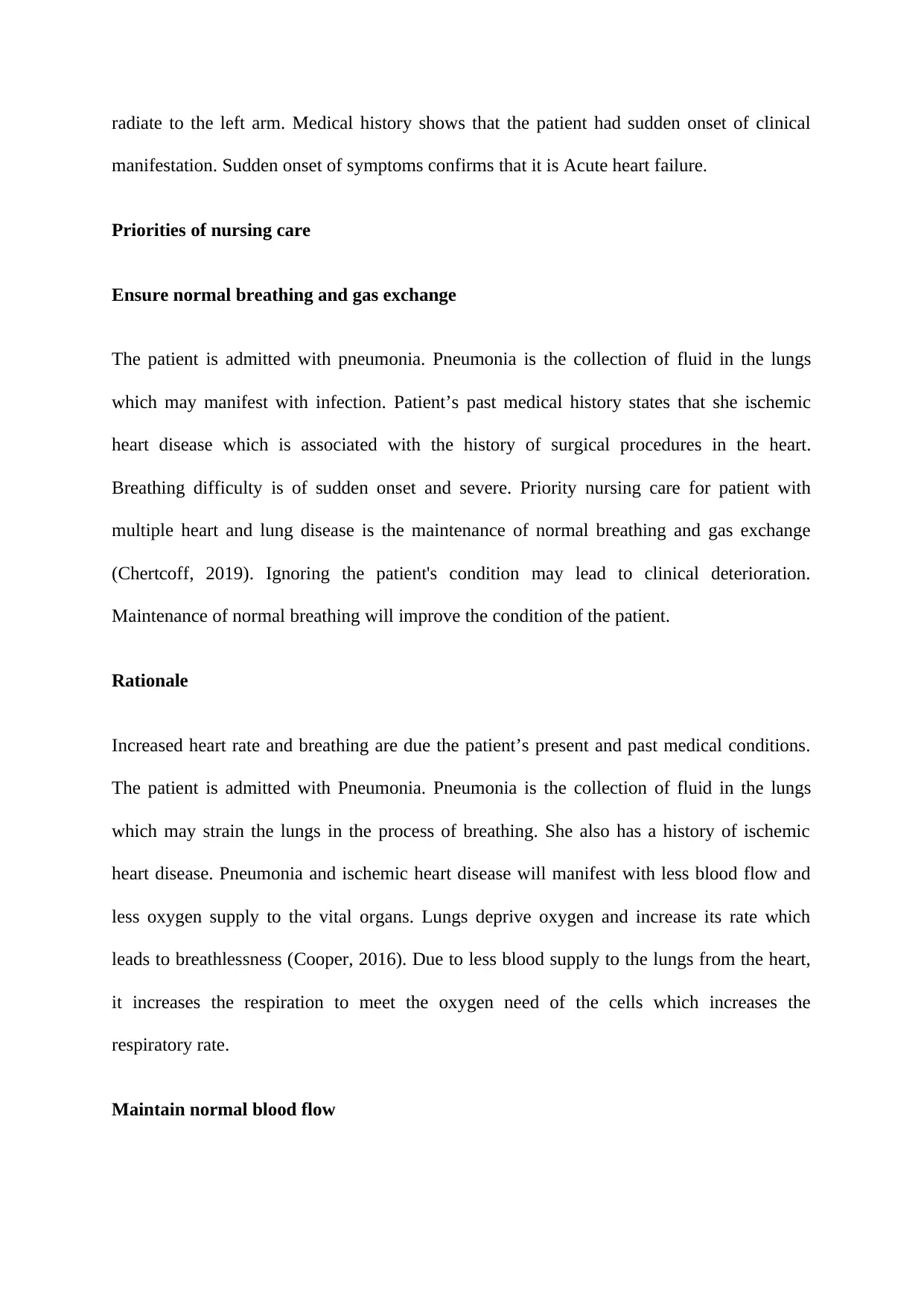
radiate to the left arm. Medical history shows that the patient had sudden onset of clinical
manifestation. Sudden onset of symptoms confirms that it is Acute heart failure.
Priorities of nursing care
Ensure normal breathing and gas exchange
The patient is admitted with pneumonia. Pneumonia is the collection of fluid in the lungs
which may manifest with infection. Patient’s past medical history states that she ischemic
heart disease which is associated with the history of surgical procedures in the heart.
Breathing difficulty is of sudden onset and severe. Priority nursing care for patient with
multiple heart and lung disease is the maintenance of normal breathing and gas exchange
(Chertcoff, 2019). Ignoring the patient's condition may lead to clinical deterioration.
Maintenance of normal breathing will improve the condition of the patient.
Rationale
Increased heart rate and breathing are due the patient’s present and past medical conditions.
The patient is admitted with Pneumonia. Pneumonia is the collection of fluid in the lungs
which may strain the lungs in the process of breathing. She also has a history of ischemic
heart disease. Pneumonia and ischemic heart disease will manifest with less blood flow and
less oxygen supply to the vital organs. Lungs deprive oxygen and increase its rate which
leads to breathlessness (Cooper, 2016). Due to less blood supply to the lungs from the heart,
it increases the respiration to meet the oxygen need of the cells which increases the
respiratory rate.
Maintain normal blood flow
manifestation. Sudden onset of symptoms confirms that it is Acute heart failure.
Priorities of nursing care
Ensure normal breathing and gas exchange
The patient is admitted with pneumonia. Pneumonia is the collection of fluid in the lungs
which may manifest with infection. Patient’s past medical history states that she ischemic
heart disease which is associated with the history of surgical procedures in the heart.
Breathing difficulty is of sudden onset and severe. Priority nursing care for patient with
multiple heart and lung disease is the maintenance of normal breathing and gas exchange
(Chertcoff, 2019). Ignoring the patient's condition may lead to clinical deterioration.
Maintenance of normal breathing will improve the condition of the patient.
Rationale
Increased heart rate and breathing are due the patient’s present and past medical conditions.
The patient is admitted with Pneumonia. Pneumonia is the collection of fluid in the lungs
which may strain the lungs in the process of breathing. She also has a history of ischemic
heart disease. Pneumonia and ischemic heart disease will manifest with less blood flow and
less oxygen supply to the vital organs. Lungs deprive oxygen and increase its rate which
leads to breathlessness (Cooper, 2016). Due to less blood supply to the lungs from the heart,
it increases the respiration to meet the oxygen need of the cells which increases the
respiratory rate.
Maintain normal blood flow
⊘ This is a preview!⊘
Do you want full access?
Subscribe today to unlock all pages.

Trusted by 1+ million students worldwide
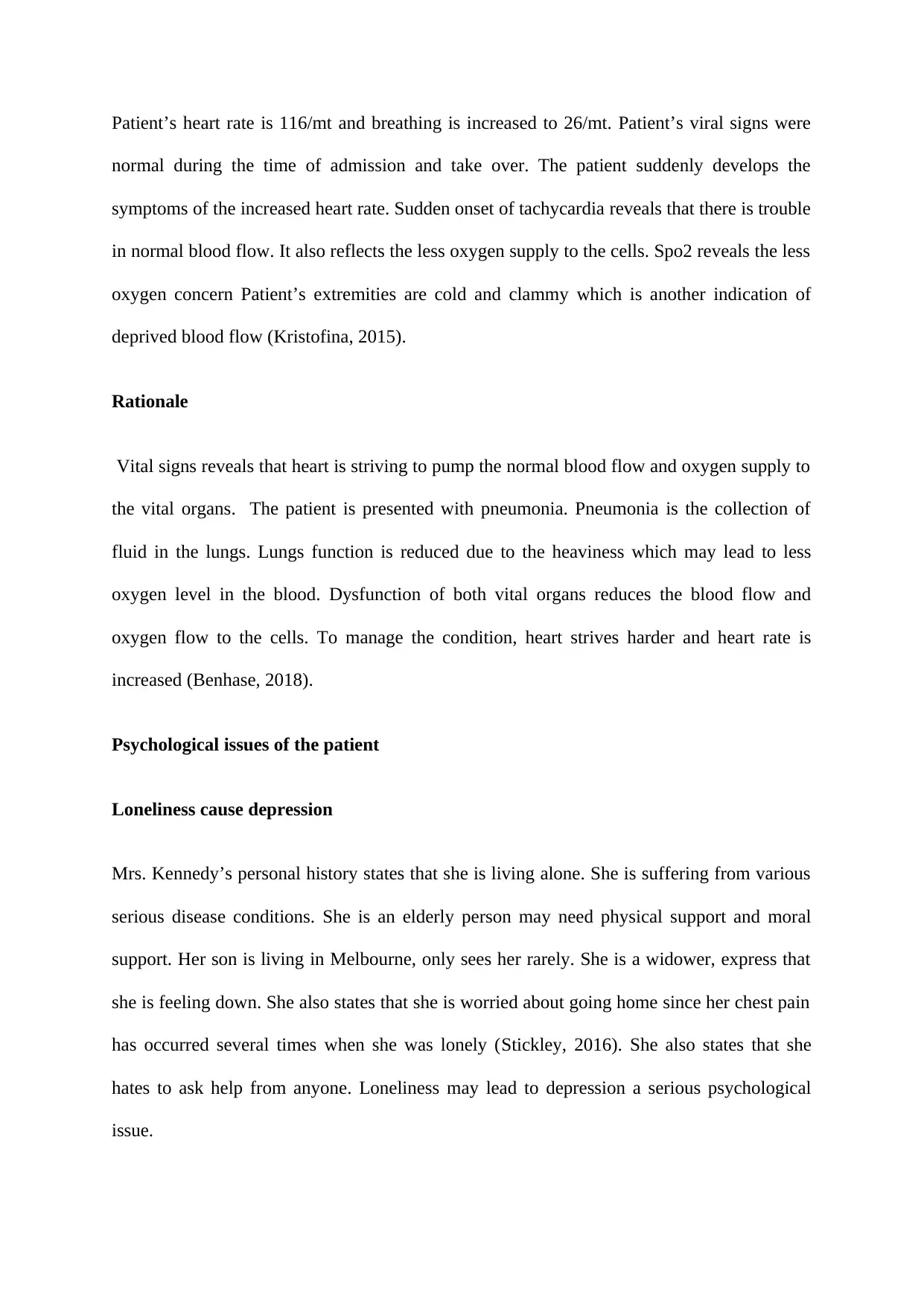
Patient’s heart rate is 116/mt and breathing is increased to 26/mt. Patient’s viral signs were
normal during the time of admission and take over. The patient suddenly develops the
symptoms of the increased heart rate. Sudden onset of tachycardia reveals that there is trouble
in normal blood flow. It also reflects the less oxygen supply to the cells. Spo2 reveals the less
oxygen concern Patient’s extremities are cold and clammy which is another indication of
deprived blood flow (Kristofina, 2015).
Rationale
Vital signs reveals that heart is striving to pump the normal blood flow and oxygen supply to
the vital organs. The patient is presented with pneumonia. Pneumonia is the collection of
fluid in the lungs. Lungs function is reduced due to the heaviness which may lead to less
oxygen level in the blood. Dysfunction of both vital organs reduces the blood flow and
oxygen flow to the cells. To manage the condition, heart strives harder and heart rate is
increased (Benhase, 2018).
Psychological issues of the patient
Loneliness cause depression
Mrs. Kennedy’s personal history states that she is living alone. She is suffering from various
serious disease conditions. She is an elderly person may need physical support and moral
support. Her son is living in Melbourne, only sees her rarely. She is a widower, express that
she is feeling down. She also states that she is worried about going home since her chest pain
has occurred several times when she was lonely (Stickley, 2016). She also states that she
hates to ask help from anyone. Loneliness may lead to depression a serious psychological
issue.
normal during the time of admission and take over. The patient suddenly develops the
symptoms of the increased heart rate. Sudden onset of tachycardia reveals that there is trouble
in normal blood flow. It also reflects the less oxygen supply to the cells. Spo2 reveals the less
oxygen concern Patient’s extremities are cold and clammy which is another indication of
deprived blood flow (Kristofina, 2015).
Rationale
Vital signs reveals that heart is striving to pump the normal blood flow and oxygen supply to
the vital organs. The patient is presented with pneumonia. Pneumonia is the collection of
fluid in the lungs. Lungs function is reduced due to the heaviness which may lead to less
oxygen level in the blood. Dysfunction of both vital organs reduces the blood flow and
oxygen flow to the cells. To manage the condition, heart strives harder and heart rate is
increased (Benhase, 2018).
Psychological issues of the patient
Loneliness cause depression
Mrs. Kennedy’s personal history states that she is living alone. She is suffering from various
serious disease conditions. She is an elderly person may need physical support and moral
support. Her son is living in Melbourne, only sees her rarely. She is a widower, express that
she is feeling down. She also states that she is worried about going home since her chest pain
has occurred several times when she was lonely (Stickley, 2016). She also states that she
hates to ask help from anyone. Loneliness may lead to depression a serious psychological
issue.
Paraphrase This Document
Need a fresh take? Get an instant paraphrase of this document with our AI Paraphraser
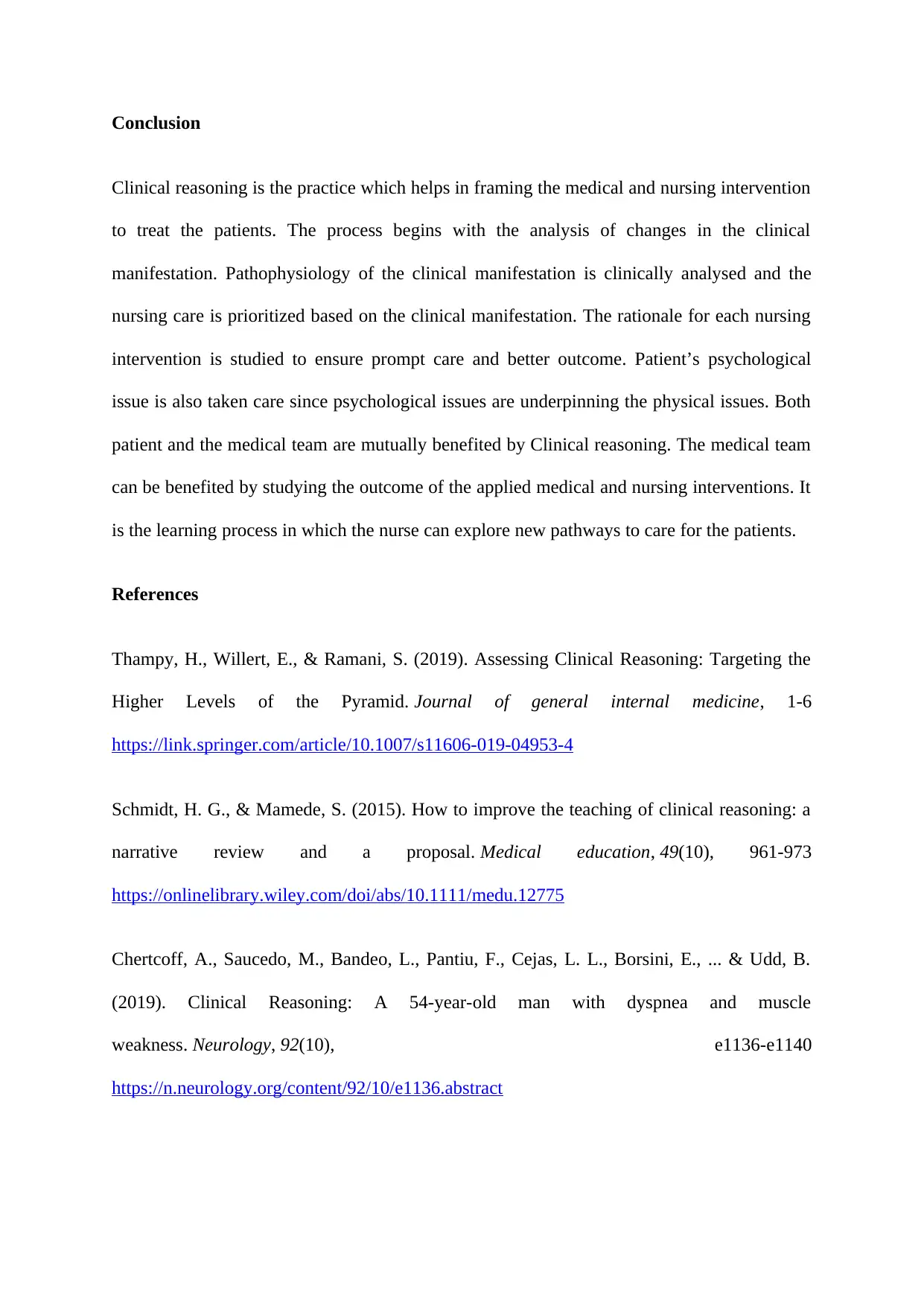
Conclusion
Clinical reasoning is the practice which helps in framing the medical and nursing intervention
to treat the patients. The process begins with the analysis of changes in the clinical
manifestation. Pathophysiology of the clinical manifestation is clinically analysed and the
nursing care is prioritized based on the clinical manifestation. The rationale for each nursing
intervention is studied to ensure prompt care and better outcome. Patient’s psychological
issue is also taken care since psychological issues are underpinning the physical issues. Both
patient and the medical team are mutually benefited by Clinical reasoning. The medical team
can be benefited by studying the outcome of the applied medical and nursing interventions. It
is the learning process in which the nurse can explore new pathways to care for the patients.
References
Thampy, H., Willert, E., & Ramani, S. (2019). Assessing Clinical Reasoning: Targeting the
Higher Levels of the Pyramid. Journal of general internal medicine, 1-6
https://link.springer.com/article/10.1007/s11606-019-04953-4
Schmidt, H. G., & Mamede, S. (2015). How to improve the teaching of clinical reasoning: a
narrative review and a proposal. Medical education, 49(10), 961-973
https://onlinelibrary.wiley.com/doi/abs/10.1111/medu.12775
Chertcoff, A., Saucedo, M., Bandeo, L., Pantiu, F., Cejas, L. L., Borsini, E., ... & Udd, B.
(2019). Clinical Reasoning: A 54-year-old man with dyspnea and muscle
weakness. Neurology, 92(10), e1136-e1140
https://n.neurology.org/content/92/10/e1136.abstract
Clinical reasoning is the practice which helps in framing the medical and nursing intervention
to treat the patients. The process begins with the analysis of changes in the clinical
manifestation. Pathophysiology of the clinical manifestation is clinically analysed and the
nursing care is prioritized based on the clinical manifestation. The rationale for each nursing
intervention is studied to ensure prompt care and better outcome. Patient’s psychological
issue is also taken care since psychological issues are underpinning the physical issues. Both
patient and the medical team are mutually benefited by Clinical reasoning. The medical team
can be benefited by studying the outcome of the applied medical and nursing interventions. It
is the learning process in which the nurse can explore new pathways to care for the patients.
References
Thampy, H., Willert, E., & Ramani, S. (2019). Assessing Clinical Reasoning: Targeting the
Higher Levels of the Pyramid. Journal of general internal medicine, 1-6
https://link.springer.com/article/10.1007/s11606-019-04953-4
Schmidt, H. G., & Mamede, S. (2015). How to improve the teaching of clinical reasoning: a
narrative review and a proposal. Medical education, 49(10), 961-973
https://onlinelibrary.wiley.com/doi/abs/10.1111/medu.12775
Chertcoff, A., Saucedo, M., Bandeo, L., Pantiu, F., Cejas, L. L., Borsini, E., ... & Udd, B.
(2019). Clinical Reasoning: A 54-year-old man with dyspnea and muscle
weakness. Neurology, 92(10), e1136-e1140
https://n.neurology.org/content/92/10/e1136.abstract
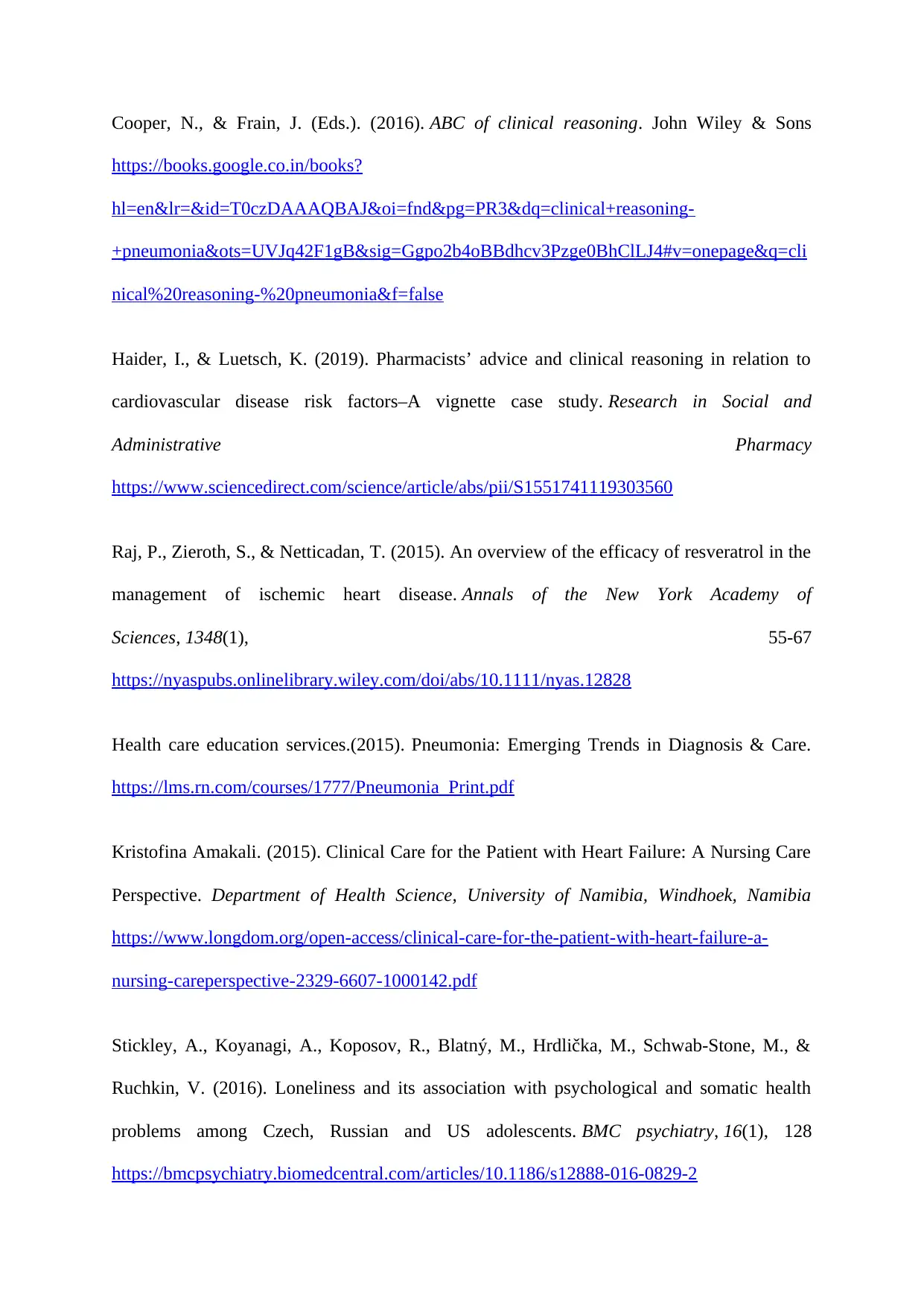
Cooper, N., & Frain, J. (Eds.). (2016). ABC of clinical reasoning. John Wiley & Sons
https://books.google.co.in/books?
hl=en&lr=&id=T0czDAAAQBAJ&oi=fnd&pg=PR3&dq=clinical+reasoning-
+pneumonia&ots=UVJq42F1gB&sig=Ggpo2b4oBBdhcv3Pzge0BhClLJ4#v=onepage&q=cli
nical%20reasoning-%20pneumonia&f=false
Haider, I., & Luetsch, K. (2019). Pharmacists’ advice and clinical reasoning in relation to
cardiovascular disease risk factors–A vignette case study. Research in Social and
Administrative Pharmacy
https://www.sciencedirect.com/science/article/abs/pii/S1551741119303560
Raj, P., Zieroth, S., & Netticadan, T. (2015). An overview of the efficacy of resveratrol in the
management of ischemic heart disease. Annals of the New York Academy of
Sciences, 1348(1), 55-67
https://nyaspubs.onlinelibrary.wiley.com/doi/abs/10.1111/nyas.12828
Health care education services.(2015). Pneumonia: Emerging Trends in Diagnosis & Care.
https://lms.rn.com/courses/1777/Pneumonia_Print.pdf
Kristofina Amakali. (2015). Clinical Care for the Patient with Heart Failure: A Nursing Care
Perspective. Department of Health Science, University of Namibia, Windhoek, Namibia
https://www.longdom.org/open-access/clinical-care-for-the-patient-with-heart-failure-a-
nursing-careperspective-2329-6607-1000142.pdf
Stickley, A., Koyanagi, A., Koposov, R., Blatný, M., Hrdlička, M., Schwab-Stone, M., &
Ruchkin, V. (2016). Loneliness and its association with psychological and somatic health
problems among Czech, Russian and US adolescents. BMC psychiatry, 16(1), 128
https://bmcpsychiatry.biomedcentral.com/articles/10.1186/s12888-016-0829-2
https://books.google.co.in/books?
hl=en&lr=&id=T0czDAAAQBAJ&oi=fnd&pg=PR3&dq=clinical+reasoning-
+pneumonia&ots=UVJq42F1gB&sig=Ggpo2b4oBBdhcv3Pzge0BhClLJ4#v=onepage&q=cli
nical%20reasoning-%20pneumonia&f=false
Haider, I., & Luetsch, K. (2019). Pharmacists’ advice and clinical reasoning in relation to
cardiovascular disease risk factors–A vignette case study. Research in Social and
Administrative Pharmacy
https://www.sciencedirect.com/science/article/abs/pii/S1551741119303560
Raj, P., Zieroth, S., & Netticadan, T. (2015). An overview of the efficacy of resveratrol in the
management of ischemic heart disease. Annals of the New York Academy of
Sciences, 1348(1), 55-67
https://nyaspubs.onlinelibrary.wiley.com/doi/abs/10.1111/nyas.12828
Health care education services.(2015). Pneumonia: Emerging Trends in Diagnosis & Care.
https://lms.rn.com/courses/1777/Pneumonia_Print.pdf
Kristofina Amakali. (2015). Clinical Care for the Patient with Heart Failure: A Nursing Care
Perspective. Department of Health Science, University of Namibia, Windhoek, Namibia
https://www.longdom.org/open-access/clinical-care-for-the-patient-with-heart-failure-a-
nursing-careperspective-2329-6607-1000142.pdf
Stickley, A., Koyanagi, A., Koposov, R., Blatný, M., Hrdlička, M., Schwab-Stone, M., &
Ruchkin, V. (2016). Loneliness and its association with psychological and somatic health
problems among Czech, Russian and US adolescents. BMC psychiatry, 16(1), 128
https://bmcpsychiatry.biomedcentral.com/articles/10.1186/s12888-016-0829-2
⊘ This is a preview!⊘
Do you want full access?
Subscribe today to unlock all pages.

Trusted by 1+ million students worldwide

Benhase, C., Faulkner, T. J., Hendricks, K., & Sublett, J. (2018). Nursing Aspects of Heart
Failure. In Heart Failure in the Child and Young Adult (pp. 481-492). Academic Press.
https://www.sciencedirect.com/science/article/pii/B9780128023938000375
Failure. In Heart Failure in the Child and Young Adult (pp. 481-492). Academic Press.
https://www.sciencedirect.com/science/article/pii/B9780128023938000375
1 out of 7
Related Documents
Your All-in-One AI-Powered Toolkit for Academic Success.
+13062052269
info@desklib.com
Available 24*7 on WhatsApp / Email
![[object Object]](/_next/static/media/star-bottom.7253800d.svg)
Unlock your academic potential
Copyright © 2020–2025 A2Z Services. All Rights Reserved. Developed and managed by ZUCOL.




